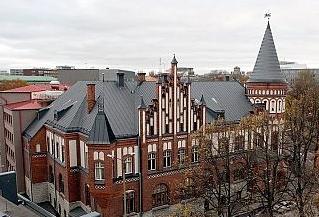Analytics, Baltic States – CIS, Economics, Estonia, EU – Baltic States, Financial Services, Markets and Companies
International Internet Magazine. Baltic States news & analytics
Thursday, 25.04.2024, 06:30
Eesti Pank: risks to Estonian financial stability from the external environment have increased
 Print version
Print version |
|---|
Eesti Pank said that despite the recovery of economic growth, the banking sector in the euro area still has relatively large levels of problem loans and low profitability. Before the Single Supervisory Mechanism for banks starts operating at the European Central Bank, comprehensive assessments of assets are being carried out for the biggest banks in the euro area. This should encourage the return of investor confidence in the banks of the euro area and promote the lending needed for economies to recover. One danger is that the events in Ukraine have increased the geopolitical risks, and how this affects the Estonian economy and financial stability will depend on how the risks are realised. The direct exposures of the Estonian financial sector in Ukraine and Russia are small and so the immediate systemic risk is limited.
Estonian economic growth in 2013 was driven by strengthened domestic demand, which draws on growth in household consumption. This was facilitated by a fall in unemployment and stronger real income growth. As economic growth picks up in Europe, the contribution of the exporting sector is expected to increase. Investments are not restricted by corporate finances or bank lending policies, so faster growth in Estonia depends on confidence and a recovery in external demand. If Estonia is to benefit from the recovery in the European economy though, it is important that the increasing wage pressure of recent years does not limit the competitiveness of companies in export markets, the central bank said.
Eesti Pank said that any deterioration in the external environment risks damaging the outlook for economic growth in Estonia and worsening the loan quality of banks. On top of the risks stemming from the recovery of growth in the euro area, political uncertainty has increased following the events in Ukraine, and with it uncertainty about economic developments in trading partners. This uncertainty about the future can have an immediate cross-border effect, and it can also worsen the outlook for economic growth as investment projects may be put on hold and consumption may be limited. If the Estonian economy were to be subjected to a shock like the 1998 Russian crisis or the 2008 global financial crisis, it would lead to an increase in problem loans. The financial buffers of households and companies mean that the impact of this would now be much smaller. Furthermore, the capital buffers of the banks are significantly larger and Eesti Pank is planning to impose a 2% systemic risk buffer so that such risks can better be managed.
Eesti Pank said also that there remains the danger that the risk assessment for the Nordic economies and banks could worsen, which would increase the funding and liquidity risks of the parent banking groups. Nordic bank groups have over 90% of the Estonian banking market, and Swedish banks have around 80%. Continued rises in real estate prices and household borrowing in Sweden have increased the risks to financial stability, as Swedish banks partly finance their lending with funds from financial markets. Steps have been taken in Sweden to dampen the risks by strengthening the capital and liquidity buffers of banks, as it is seen as necessary to balance the funding structures of the banks. Although the Swedish central bank and supervisory authority have noted the need for changes to limit the credit growth of households and to reduce their indebtedness, the impact of such changes may not be sufficient. The possible impact of this risk on the Estonian financial sector is reduced by the fact that the banks operating in Estonia mainly fund themselves from local deposits.
The rapid rise in Estonian real estate prices could lead to riskier borrowing behaviour by households and companies and cause risks to the financial system to build up, Eesti Pank said. Apartment prices were up by over 20% at the end of 2013 and the rapid growth has continued this year. The increase in activity in the housing market can partly be explained by an improvement in household confidence and in the labour market, and by growth in incomes. Low interest rates enhance the risk that the constant strong growth in real estate prices will lead to overly optimistic expectations among households about the sustainability of growth. One factor lowering the risks to financial stability is that households have used a lot more of their own funds in purchasing real estate than they did during the boom and bank loans are being used less. As long as bank lending standards are not eased and the loan growth remains moderate, there is no great risk to financial stability from the rapid rises in real estate prices. However, it will be important that banks continue to follow responsible lending principles when assessing the loan repayment ability of borrowers and requiring them to make sufficient down payments. Eesti Pank is prepared to impose requirements for stricter lending conditions if necessary.








 «The Baltic Course» Is Sold and Stays in Business!
«The Baltic Course» Is Sold and Stays in Business!

